Table of Contents
- Introduction
- Editor’s Choice
- Global Ethanol Market Overview
- Chemical Properties of Ethanol Statistics
- Fuel Ethanol Statistics
- Global Ethanol Export Statistics
- Global Ethanol Import Statistics
- Ethanol Price Statistics
- Ethanol Compatibility in Vehicle Fleet Statistics
- Regulations for Ethanol in Different Countries Statistics
- Recent Developments
- Conclusion
- FAQs
Introduction
Ethanol Statistics: Ethanol, or ethyl alcohol (C2H5OH), is a versatile chemical compound utilized primarily as a biofuel additive in gasoline and as a key ingredient in alcoholic beverages.
It is typically produced through the fermentation of sugars from various feedstocks such as corn, sugarcane, and cellulose-based materials.
Ethanol serves as a renewable energy source, with lower overall carbon emissions compared to fossil fuels. However, challenges include feedstock availability, land use concerns, and energy balance considerations.
Despite these challenges, ethanol plays a significant role in reducing greenhouse gas emissions and promoting renewable energy adoption. Supported by regulatory frameworks mandating its use in fuel blends and incentivizing production.

Editor’s Choice
- The global ethanol market revenue reached 108.0 billion in 2023.
- North America leads the market with a substantial share of 40.0%. Owing to its well-established ethanol production infrastructure and supportive regulatory environment.
- Among companies, AB Miller and Archer Daniels Midland Company hold significant shares, each commanding 14% of the market.
- Ethanol is commonly used in various industries and is subject to exposure limits, with a TLV-TWA of 1900 mg/m3.
- The United States stood at the forefront with a production volume of 15,550 million gallons.
- In March 2024, in North America, the price of ethanol was recorded at US$0.59 per kilogram, marking a 1.7% increase from the previous period.
- Ethanol production, distribution, and blending are regulated by the Environmental Protection Agency (EPA) under the Renewable Fuel Standard (RFS) program.

Global Ethanol Market Overview
Global Ethanol Market Size
- The global ethanol market has witnessed steady growth in revenue over the past decade at a CAGR of 4.9%. With a consistent upward trend projected into the foreseeable future.
- In 2022, the market revenue stood at USD 103.0 billion, climbing to USD 108.0 billion in 2023.
- This positive trajectory continued with revenues reaching USD 112.0 billion in 2024 and further increasing to USD 119.0 billion in 2025.
- Projections indicate continued expansion, with revenues expected to reach USD 126.0 billion in 2026, USD 131.0 billion in 2027, and USD 135.0 billion in 2028.
- By 2030, the market is anticipated to surpass USD 148.0 billion. With continued growth reaching USD 155.0 billion in 2031 and USD 164.0 billion in 2032.
- This sustained growth reflects the increasing demand for ethanol as a biofuel additive and its prominence in various industries. Driven by factors such as environmental regulations, renewable energy initiatives, and technological advancements in ethanol production.
(Source: Market.us)
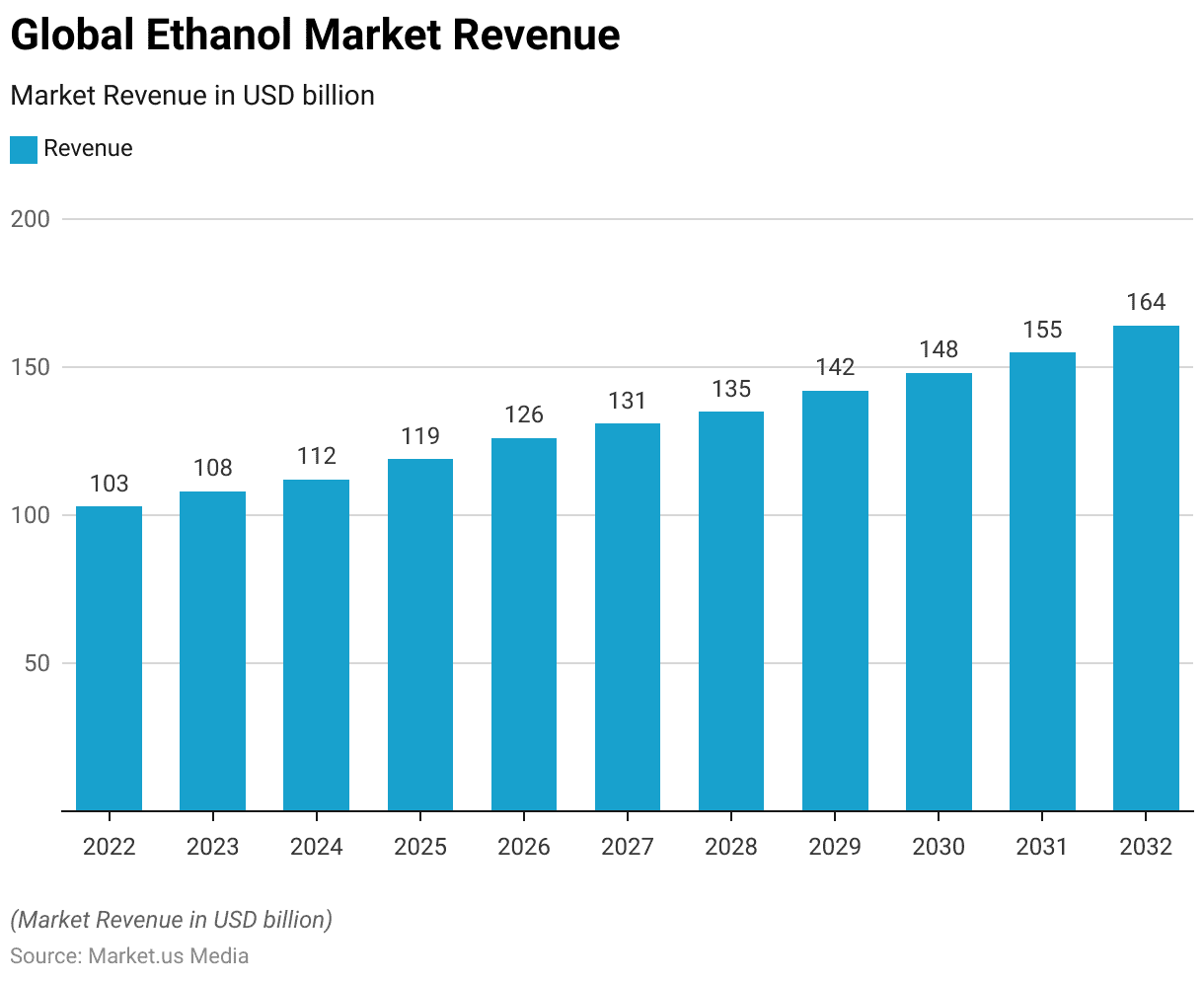
Regional Analysis of the Global Ethanol Market
- The global ethanol market is distributed among several key regions, each contributing to its overall composition.
- North America leads the market with a substantial share of 40.0%, owing to its well-established ethanol production infrastructure and supportive regulatory environment.
- Following closely behind is the Asia-Pacific (APAC) region, holding 21.0% of the market share, driven by increasing demand for biofuels amid growing energy needs and environmental concerns.
- Europe accounts for 16.0% of the market, emphasizing its commitment to reducing carbon emissions through renewable energy sources like ethanol.
- Latin America holds a significant share of 19.0%, largely attributed to ethanol production from sugarcane.
- Lastly, the Middle East & Africa (MEA) region contributes 4.0% to the global ethanol market, indicating a growing interest in renewable energy alternatives despite its comparatively smaller share.
- These regional variations underscore the global importance of ethanol as a renewable energy solution and highlight diverse market dynamics influenced by regional policies, resources, and economic factors.
(Source: Market.us)
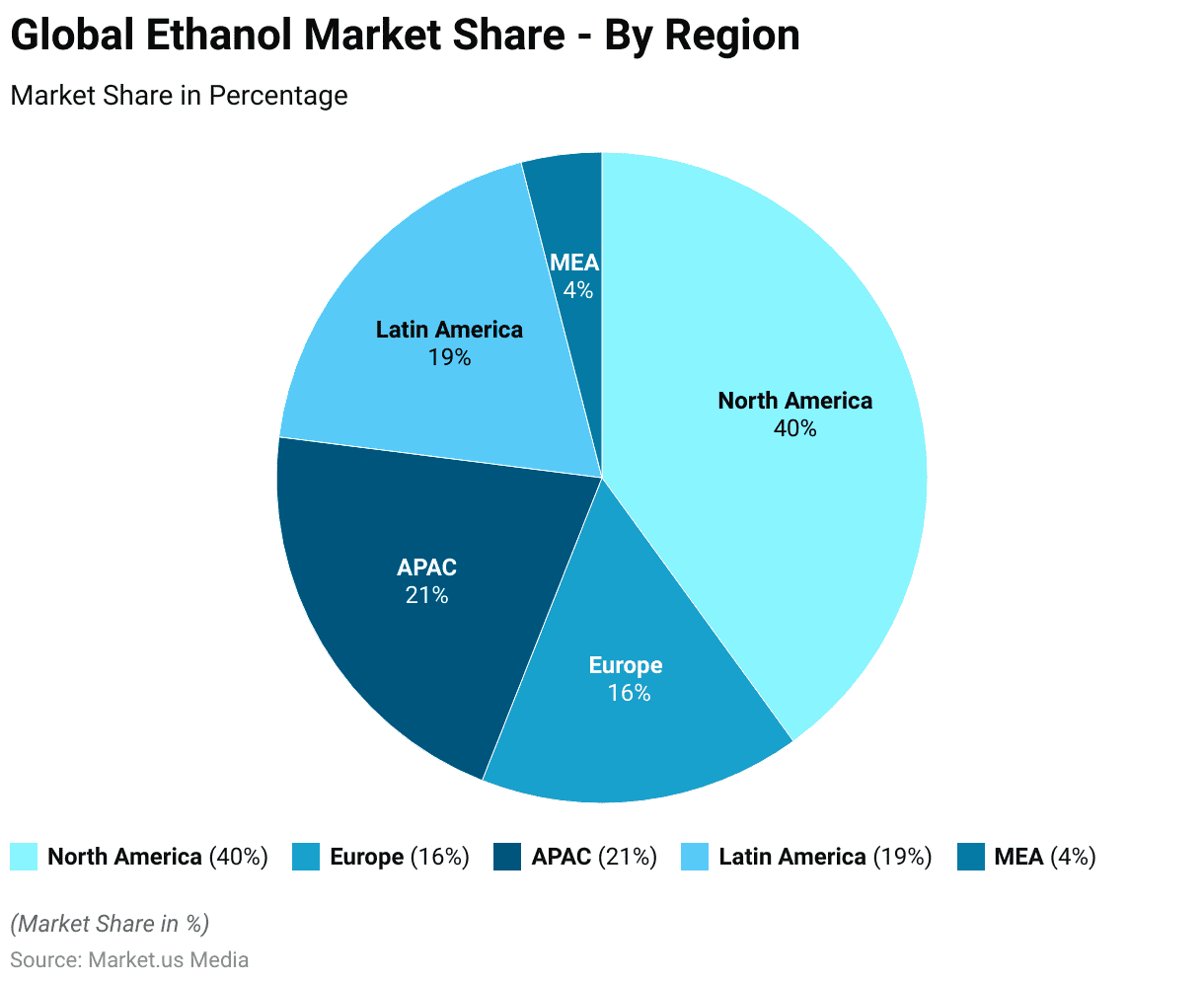
Competitive Landscape of Global Ethanol Market
- A diverse landscape of key players characterizes the ethanol market, each vying for market share and contributing to the industry’s overall dynamics.
- Among these, AB Miller and Archer Daniels Midland Company hold significant shares, each commanding 14% of the market.
- United Breweries, Pure Energy Inc., and British Petroleum closely follow, each securing a 13% share.
- Aventine Renewable Energy and other key players each claim 12% of the market, demonstrating their substantial presence in the industry.
- Kirin, with an 11% share, adds to the competitive mix, reflecting the global reach of ethanol producers.
- These companies play pivotal roles in ethanol production, distribution, and innovation, shaping market trends and strategies.
- Their collective efforts drive the growth and evolution of the ethanol industry, responding to consumer demands, regulatory requirements, and technological advancements.
(Source: Market.us)
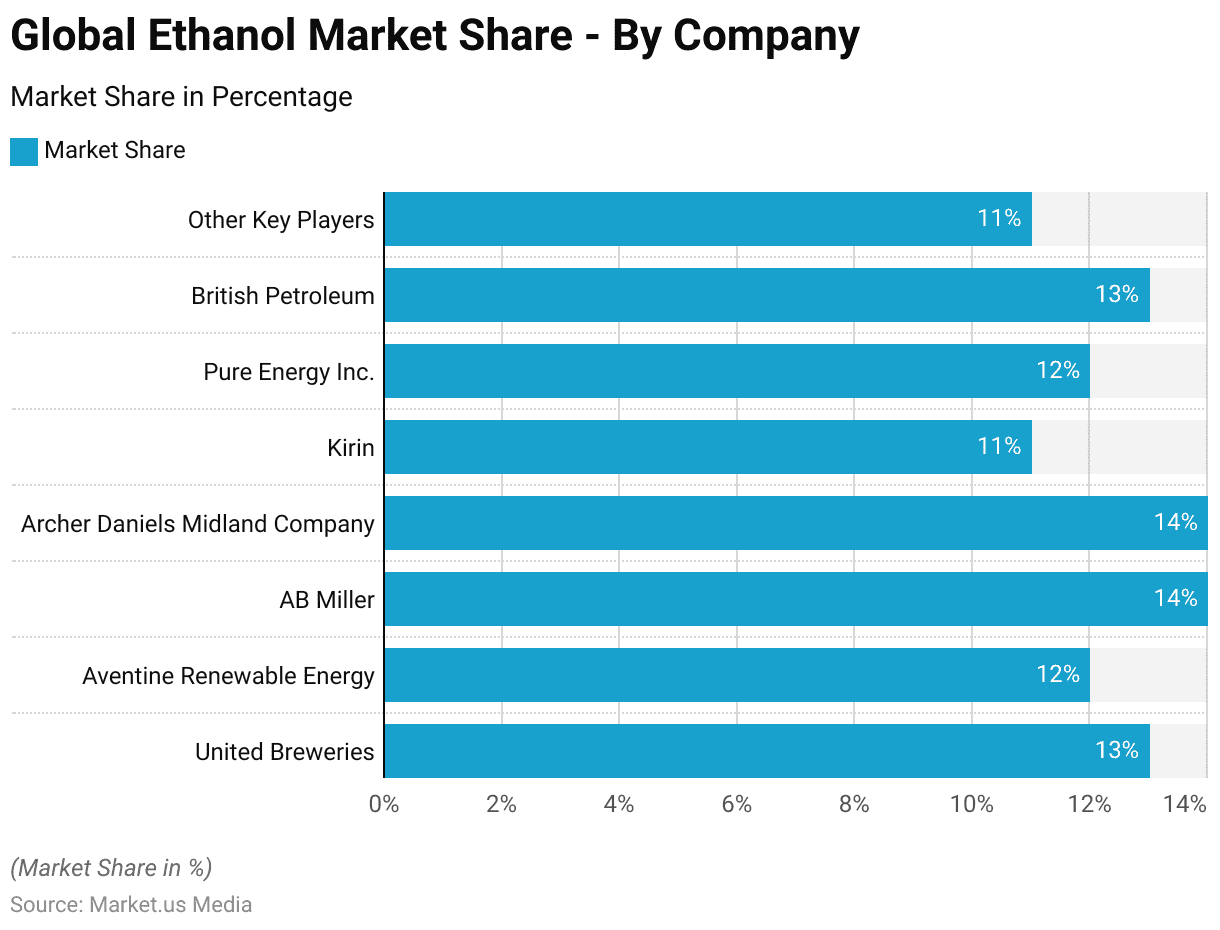
Chemical Properties of Ethanol Statistics
- Ethanol, also known as ethyl alcohol, exhibits various physical and chemical properties. It is a colorless liquid with a pleasant alcoholic odor, melting at –114°C and boiling at 78°C.
- Ethanol has a density of 0.789 g/mL at 20°C and is completely soluble in water. It has a flash point of 12°C and is stable at room temperature.
- Ethanol is hygroscopic and forms explosive mixtures with air. The odor threshold for ethanol is 0.52 ppm, and it has a refractive index of 1.3614.
- It is miscible with water and has a dielectric constant of 24.3 at 25°C.
- Ethanol is commonly used in various industries and is subject to exposure limits, with a TLV-TWA of 1900 mg/m3.
- It is stable under proper conditions but should be stored away from strong oxidizing agents, peroxides, acids, and alkali metals.
- Ethanol is a widely used substance with applications in food, pharmaceuticals, and industrial processes.
(Source: ChemicalBook)
Fuel Ethanol Statistics
Fuel Ethanol Consumption Statistics
- Fuel ethanol consumption has shown fluctuating trends over the past decade, with varying levels of demand observed annually.
- In 2015, consumption stood at 119.92 billion liters, experiencing minor fluctuations in the following years.
- However, a notable increase was recorded in 2018, with consumption rising to 127.18 billion liters, followed by further growth to 131.4 billion liters in 2019.
- Despite this upward trajectory, consumption declined in 2020 to 119.01 billion liters, possibly influenced by global events or market dynamics.
- However, a rebound occurred in 2021, with consumption reaching 124.87 billion liters.
- Subsequent years saw steady growth, with consumption expected to rise to 147.83 billion liters by 2030.
- These trends reflect the evolving landscape of ethanol consumption, influenced by factors such as economic conditions, regulatory policies, and technological advancements in renewable energy.
(Source: Statista)
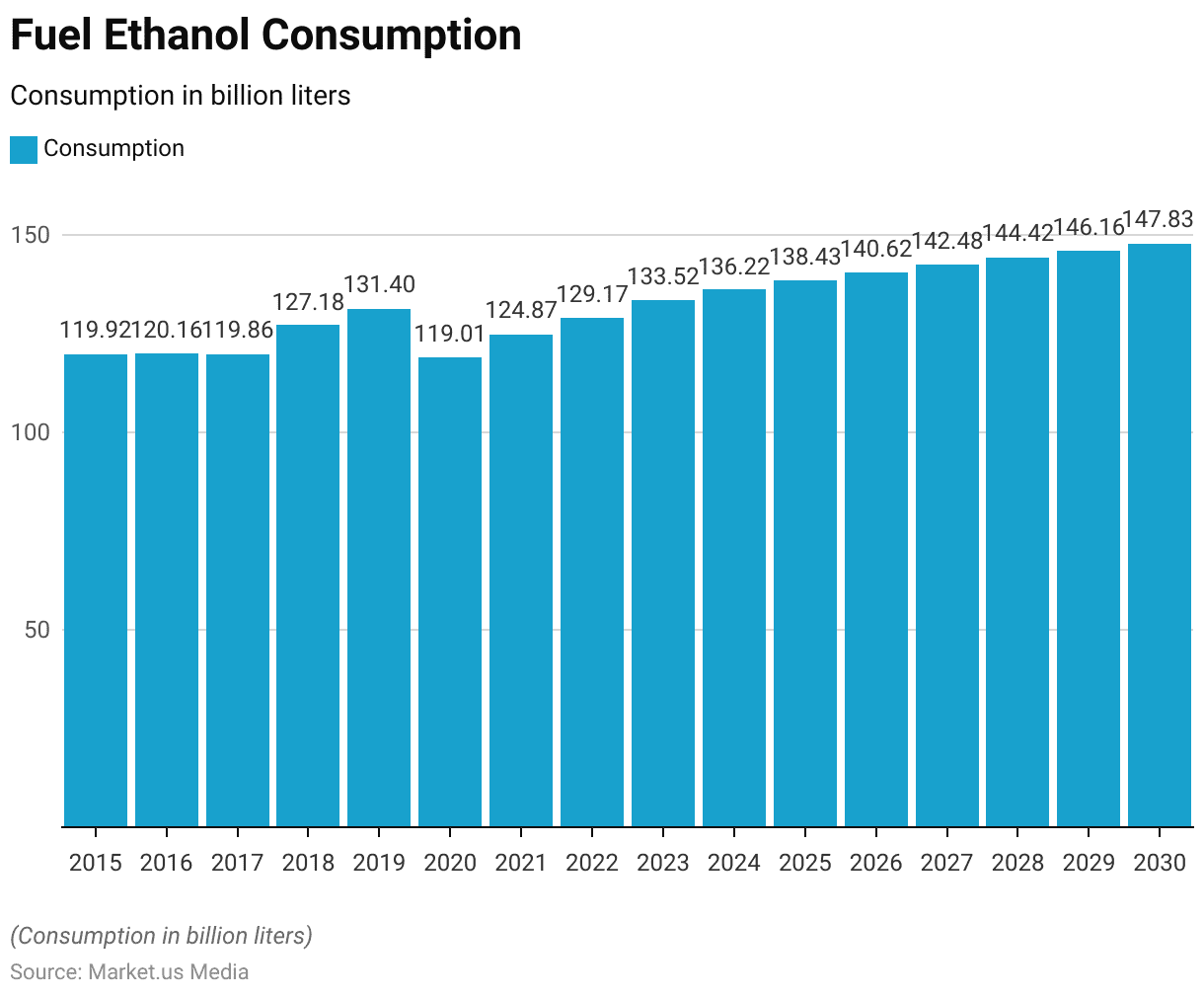
Fuel Ethanol Production – By Country Statistics
- In 2023, fuel ethanol production was led by several prominent countries, each contributing significantly to the global output.
- The United States stood at the forefront with a production volume of 15,550 million gallons, followed closely by Brazil with 8,260 million gallons.
- The European Union, India, and China also made substantial contributions, producing 1,440 million gallons, 1,430 million gallons, and 950 million gallons, respectively.
- Canada, Thailand, and Argentina followed suit with production volumes of 460 million gallons, 370 million gallons, and 300 million gallons, respectively.
- Additionally, the rest of the world collectively accounted for 760 million gallons of fuel ethanol production.
- These production figures underscore the diverse geographical distribution of ethanol manufacturing and highlight the key role played by these countries in meeting global demand for renewable energy sources.
(Source: Statista)
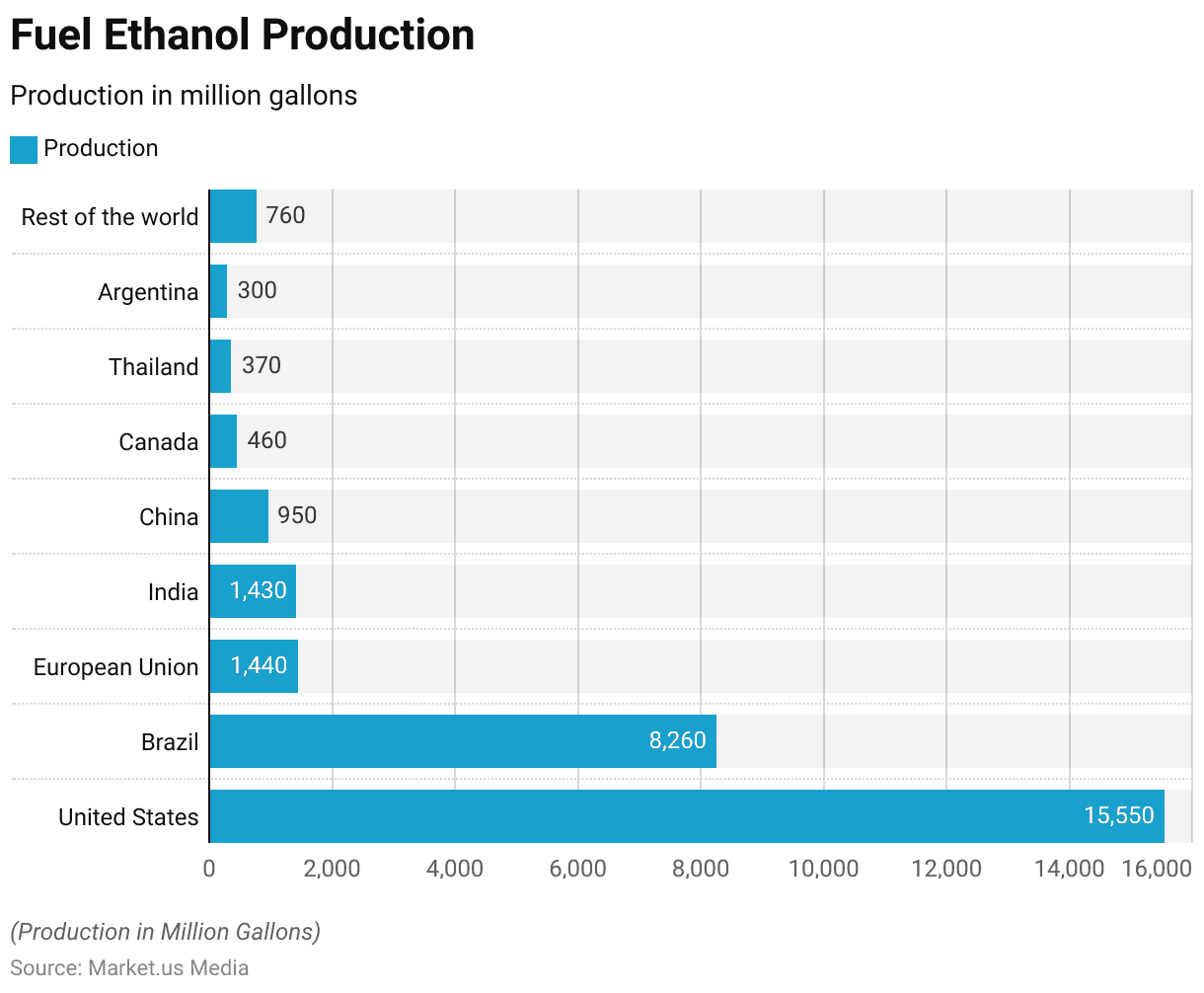
Global Ethanol Export Statistics
- In 2023, the United States maintained its position as the leading global supplier and exporter of ethanol, producing 15.6 billion gallons. Which accounted for 53% of the world’s ethanol output—nearly double that of Brazil and ten times the European Union’s production.
- National commitments to reducing greenhouse gas emissions and improving air quality. Alongside post-pandemic travel demand recovery, created significant opportunities for U.S. ethanol on a global scale.
- Exports reached a record 1.43 billion gallons, valued at $3.82 billion, equivalent to 9% of domestic production and the third-highest export volume ever.
- Approximately 73% of global demand was for denatured ethanol. The majority of U.S. ethanol exports, three-fourths, were destined for Canada, the United Kingdom, and the European Union, with the rest distributed across 80 countries.
- However, a 16% tariff-rate quota led to a decline in the Brazilian market, and U.S. ethanol exports remained restricted from entering China due to prohibitive tariffs.
- Despite this, net ethanol exports were the second-highest on record. With imports decreasing to a 13-year low of 21 million gallons, primarily sourced duty-free from Brazil to leverage the Renewable Fuel Standard and California Low Carbon Fuel Standard.
(Source: Renewable Fuels Association)
Global Ethanol Import Statistics
- Ethanol imports were distributed across several countries in varying volumes, reflecting global trade patterns and market demand.
- The United States led in ethanol imports with 49,373 shipments, followed closely by Vietnam with 43,168 shipments and Indonesia with 27,376 shipments.
- India also featured prominently, importing 22,839 shipments of ethanol.
- Germany, the Netherlands, Brazil, Belgium, Italy, and the United Kingdom followed suit, importing 8,003, 5,796, 4,905, 4,673, 4,255, and 3,680 shipments of ethanol, respectively.
- These import figures illustrate the diverse geographical distribution of the ethanol trade and highlight the importance of ethanol as a renewable energy source in various regions worldwide.
(Source: Volza)
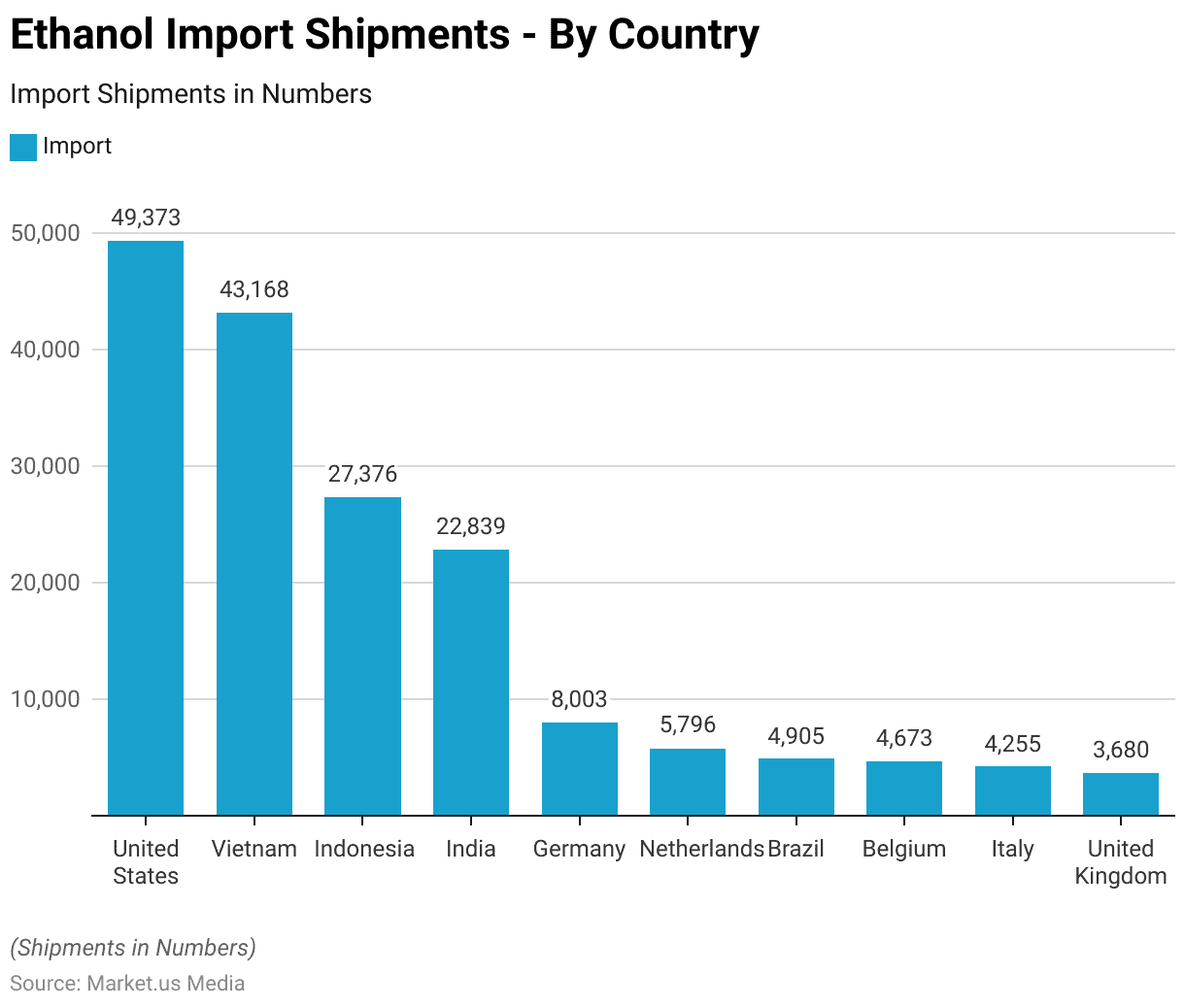
Ethanol Price Statistics
- In March 2024, ethanol prices experienced varying trends across different regions.
- In North America, the price of ethanol was recorded at US$0.59 per kilogram, marking a 1.7% increase from the previous period.
- Conversely, in Europe, ethanol prices rose to US$1.08 per kilogram, reflecting a 1.9% uptick.
- In Northeast Asia, however, ethanol prices decreased by 1.1% to US$0.87 per kilogram.
- Southeast Asia saw no change in ethanol prices, remaining at US$0.91 per kilogram.
- Meanwhile, in South America, ethanol prices climbed to US$0.69 per kilogram, representing a 1.5% increase.
- These price fluctuations are influenced by various factors, such as market demand, supply dynamics, and regional economic conditions, shaping the ethanol market landscape on a global scale.
(Source: Business Analytiq)
Ethanol Compatibility in Vehicle Fleet Statistics
- China is one of the world’s top ethanol producers, and they’ve had their CN 2 standard in place since 2004, which is quite similar to Euro 2 standards. Because Euro 2 is very close to U.S. Tier 1 standards, it’s estimated that around 98% of China’s Light Duty Vehicles (LDVs) can handle E15 blends.
- This assumption is supported by the fact that E10 is widely used in China, and there’s a national standard specifically for E10 fuels.
- In Japan, they started with emissions standards similar to U.S. Tier 0 back in the early 1980s, and they gradually moved up to Tier 1 by 2000 and Tier 2 by 2005.
- LDVs registered in Japan since 2000 should be fine with E15. However, the situation is less certain for older LDVs because Japan’s gasoline standard only allows for E3 blends.
- India is also making moves in the biofuel space, aiming for E10 by 2022 and planning to introduce E20 blending between 2023 and 2025, following certain standards.
- Since 2005, new LDVs in India have had to meet the Bharat Stage (BS) II standard. Which is similar to Euro 2 and U.S. Tier 1, suggesting they should handle E15 just fine.
- As for motorcycles in India, they’ve been complying with emissions standards since 2000, indicating that they’re likely compatible with E10. Overall, motorcycles meeting these standards or similar ones elsewhere should be good with E10 fuel.
(Source: National Renewable Energy Laboratory)
Regulations for Ethanol in Different Countries Statistics
United States (US)
- Ethanol production, distribution, and blending are regulated by the Environmental Protection Agency (EPA) under the Renewable Fuel Standard (RFS) program.
- The Food and Drug Administration (FDA) oversees the use of ethanol in food, beverages, and pharmaceuticals.
- Occupational Safety and Health Administration (OSHA) sets workplace exposure limits for ethanol.
(Source: U.S. Energy Information Administration)
European Union (EU)
- Ethanol production and use are governed by various directives and regulations, including those related to renewable energy, transportation fuels, and food safety.
- The European Chemicals Agency (ECHA) regulates ethanol under the Registration, Evaluation, Authorization, and Restriction of Chemicals (REACH) framework.
- The European Food Safety Authority (EFSA) evaluates the safety of ethanol used in food and beverages.
(Source: Official Journal of the European Union)
Brazil
- Ethanol production is regulated by the National Agency of Petroleum, Natural Gas, and Biofuels (ANP) and the Ministry of Mines and Energy (MME).
- The National Health Surveillance Agency (ANVISA) oversees the use of ethanol in food, beverages, and pharmaceuticals.
(Source: Iowa State University)
Canada
- Ethanol production and use are regulated by various federal and provincial agencies, including Natural Resources Canada (NRCan). Environment and Climate Change Canada (ECCC), and Health Canada.
- The Canadian Food Inspection Agency (CFIA) regulates ethanol use in food and beverages.
(Source: Government of Canada)
China
- Ethanol production and use are regulated by multiple government agencies, including the National Development and Reform Commission (NDRC). The Ministry of Ecology and Environment (MEE), and the National Health Commission (NHC).
- China’s National Standards for Ethanol Fuel set specifications for ethanol used as a fuel additive.
(Source: USDA Foreign Agricultural Service)
India
- Ethanol production and use are regulated by the Ministry of Petroleum and Natural Gas and the Ministry of Environment, Forest and Climate Change.
- The Food Safety and Standards Authority of India (FSSAI) oversees the use of ethanol in food and beverages.
(Source: Indian Ministry for Petroleum & Natural Gas)
Recent Developments
Acquisitions and Mergers:
- BioEnergy Group acquired Ethanol Innovations for $150 million, consolidating its position in the ethanol production market and expanding its product portfolio.
- RenewableFuel Inc. merged with Ethanol Solutions, forming a strategic alliance to leverage their combined resources for ethanol production and distribution, with projected annual revenues exceeding $500 million.
New Product Launches:
- GreenFuel introduced a next-generation ethanol production technology utilizing advanced fermentation processes, aiming to increase ethanol yield by 20% and reduce production costs by 15%.
- EcoEnergy launched a bio-based ethanol fuel blend with higher octane ratings, targeting a 30% market share in the automotive fuel sector within the next year.
Funding Rounds:
- EthanolTech received $50 million in Series B funding led by Venture Capital Firm XYZ to scale up ethanol production capacity and invest in research and development for sustainable feedstock sourcing, aiming for a 50% increase in production volume within two years.
- SustainableEnergy secured $30 million in venture capital funding from CleanTech Investors ABC to expand their ethanol distribution network and develop renewable energy infrastructure, targeting a 40% growth in market penetration.
Consumer Trends:
- Rising environmental awareness and government incentives for renewable fuels drove the demand for ethanol, with ethanol consumption increasing by 10% compared to the previous year.
- Ethanol flex-fuel vehicles witnessed a 15% growth in sales, reflecting consumer preference for cleaner and renewable fuel options in the automotive sector.
Regulatory Landscape:
- Regulatory mandates for ethanol blending in gasoline fuels continued to expand globally. With countries implementing higher ethanol content requirements to reduce greenhouse gas emissions and promote energy security.
Conclusion
Ethanol Statistics – In conclusion, recent advancements in ethanol production technologies have propelled the industry forward. Making ethanol an increasingly viable and sustainable alternative to traditional fossil fuels.
Innovations such as next-generation biofuel processes utilizing alternative feedstocks and improvements in fermentation techniques have boosted efficiency and reduced costs.
Integration of renewable energy sources and advanced process control systems further enhance the sustainability of ethanol production, contributing to reduced greenhouse gas emissions.
With ongoing research, efforts focused on optimizing production processes and increasing market opportunities. Ethanol remains a key player in the global transition towards a more sustainable energy future.
FAQs
Ethanol, also known as ethyl alcohol, is a renewable, bio-based fuel produced primarily through the fermentation of sugars found in crops such as corn, sugarcane, and barley.
Ethanol is primarily used as a fuel additive in gasoline to increase octane and reduce harmful emissions. It can also be used as a standalone fuel in flex-fuel vehicles, which can run on blends of up to 85% ethanol (E85).
Yes, ethanol is considered renewable because it is produced from biomass sources such as corn, sugarcane, and cellulosic materials, which can be replenished through agricultural practices.
Ethanol can reduce greenhouse gas emissions compared to gasoline, as it is derived from renewable biomass sources. It also helps reduce air pollution by decreasing harmful tailpipe emissions such as carbon monoxide and particulate matter.
Ethanol has a higher octane rating than gasoline, which can improve engine performance and efficiency. However, ethanol contains less energy per gallon than gasoline. So vehicles may experience a slight decrease in fuel economy when using ethanol blends.
Discuss your needs with our analyst
Please share your requirements with more details so our analyst can check if they can solve your problem(s)



